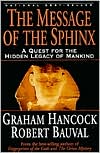The Message of the Sphinx: A Quest for the Hidden Legacy of Mankind
In this riveting account of historical and archaeological investigation, the authors present hard evidence that the Sphinx, the Pyramids, and the other monuments at Giza are of far more ancient origin than previously believed. Complete with evidence of a conspiracy between the Egyptology establishment and various confidential organizations to keep the secrets of the Pyramids from the world, The Message of the Sphinx is also a modern-day detective story. of photos.\ \ \...
Search in google:
In this riveting account of historical and archaeological investigation, the authors present hard evidence that the Sphinx, the Pyramids, and the other monuments at Giza are of far more ancient origin than previously believed. Complete with evidence of a conspiracy between the Egyptology establishment and various confidential organizations to keep the secrets of the Pyramids from the world, The Message of the Sphinx is also a modern-day detective story. of photos. Publishers Weekly Is the Sphinx of prehistoric origin? Why was it built? In this provocative, rigorously argued report, revisionist Egyptologists Hancock (The Fingerprints of the Gods) and Bauval (The Orion Mystery) join forces to answer these questions and more as they examine the Sphinx and its relation to the other monuments of the Giza plateau. Working from the premise that the Giza complex encodes a message, they begin with recently discovered geological evidence indicating that the deep erosion patterns on the flanks of the Sphinx were caused by 1000 years of heavy rain. Such conditions last existed in Egypt at the end of the last ice age, about 10,000-9,000 B.C., meaning that the Sphinx may be more than 12,000 years old (not the generally accepted 4500 years). The authors go on to suggest, using computer simulations of the sky, that the pyramids, representing the three stars of Orion's Belt, along with associated causeways and alignments, constitute a record in stone of the celestial array at the vernal equinox in 10,500 B.C. This moment, they contend, represents Zep Tepi, the "First Time," often referred to in the hieroglyphic record. They show how the initiation rituals of the Egyptian pharaohs replicate on Earth the sun's journey through the stars in this remote era, and they suggest that the "Hall of Records" of a lost civilization may be located by treating the Giza Plateau as a template of these same ancient skies. These daring, well-argued theories will raise the hackles of orthodox Egyptologistsbut that doesn't mean they're wrong. Illustrations not seen by PW. (July)
List of IllustrationsAcknowledgements1Horizon Dweller32The Riddle of the Sphinx73Mystery Piled upon Mystery234Stars and Time585The Case of the Psychic, the Scholar and the Sphinx856The Case of the Iron Plate, the Freemasons, the Relics and the Shafts1007The Case of the Robot, the Germans and the Door1178The Clues of Duality1319The Sphinx and its Horizons15210The Quest of the Horus-King16711The Unseen Academy18912Sages and 'Followers'19713Following the Stars20814Space-Time Co-ordinates21515When the Sky Joined the Earth22516Message in a Bottle?23817The Place of the 'First Time'247Conclusion268Appendix 1: The Scales of the World273Appendix 2: Precession, Proper Motion and Obliquity285Appendix 3: Correspondence with Mark Lehner290Appendix 4: Harnessing Time with the Stars298Appendix 5: Carbon-dating the Great Pyramid305References309Selected Bibliography345Index350
\ Publishers Weekly - Publisher's Weekly\ Is the Sphinx of prehistoric origin? Why was it built? In this provocative, rigorously argued report, revisionist Egyptologists Hancock (The Fingerprints of the Gods) and Bauval (The Orion Mystery) join forces to answer these questions and more as they examine the Sphinx and its relation to the other monuments of the Giza plateau. Working from the premise that the Giza complex encodes a message, they begin with recently discovered geological evidence indicating that the deep erosion patterns on the flanks of the Sphinx were caused by 1000 years of heavy rain. Such conditions last existed in Egypt at the end of the last ice age, about 10,000-9,000 B.C., meaning that the Sphinx may be more than 12,000 years old (not the generally accepted 4500 years). The authors go on to suggest, using computer simulations of the sky, that the pyramids, representing the three stars of Orion's Belt, along with associated causeways and alignments, constitute a record in stone of the celestial array at the vernal equinox in 10,500 B.C. This moment, they contend, represents Zep Tepi, the "First Time," often referred to in the hieroglyphic record. They show how the initiation rituals of the Egyptian pharaohs replicate on Earth the sun's journey through the stars in this remote era, and they suggest that the "Hall of Records" of a lost civilization may be located by treating the Giza Plateau as a template of these same ancient skies. These daring, well-argued theories will raise the hackles of orthodox Egyptologistsbut that doesn't mean they're wrong. Illustrations not seen by PW. (July)\ \ \ \ \ Library JournalThe authors of Fingerprints of the Gods (Crown, 1995) posit, among other things, that the Sphinx may be three times older than we think. A 50,000-copy first printing.\ \








